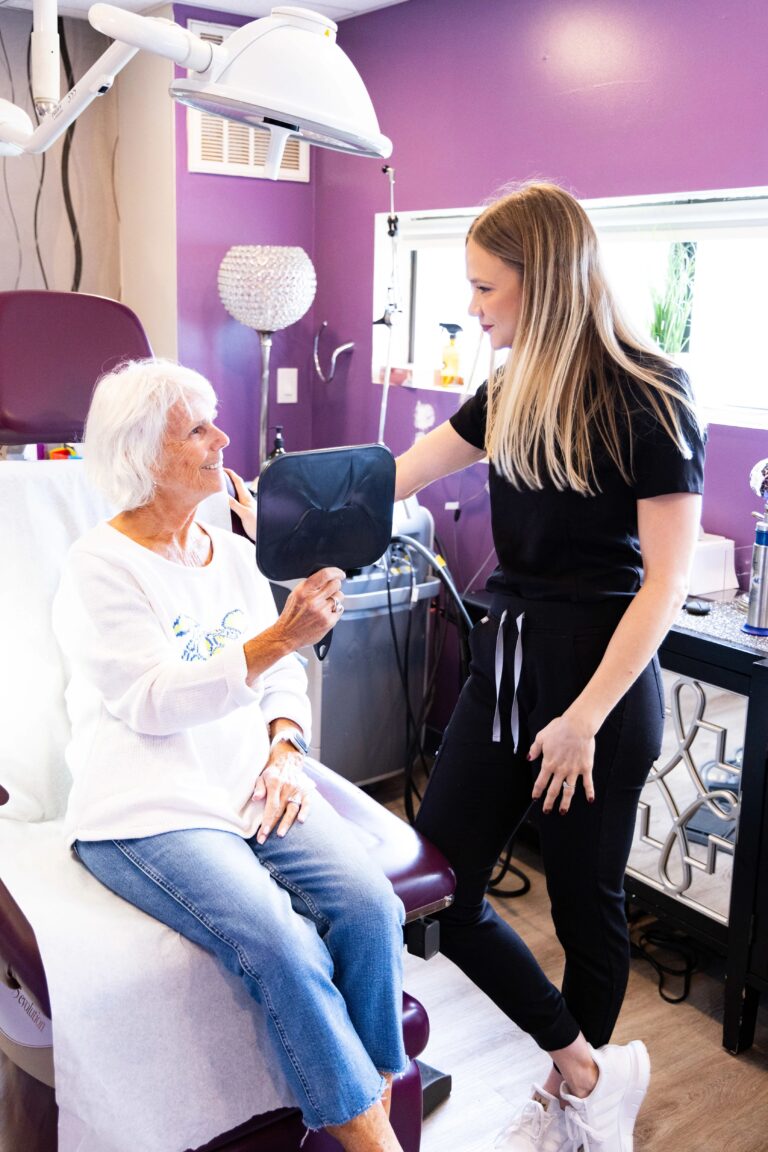What is the best treatment for 70 year old skin?
As experts in seniors dermatology, we recommend that you wash with a gentle, fragrance-free, moisturizing bar soap, cleanser, or body wash. Doing so will help soothe rather than dry your skin. Moisturizing ingredients that can help reduce dryness include ceramides, glycerin, hyaluronic acid, and lanolin. Use warm (not hot) water and don’t scrub or exfoliate your skin. Over-washing and oversoaping can lead to dryness.
Why does wound healing get harder as we age?
When you skinned your knee as a kid, the scrape healed on its own with little more than a bandage and mom’s TLC. Now that you’re older, wounds can take much longer to heal — sometimes many months. The body’s capacity to repair the skin diminishes as we get older. There aren’t as many growth factors and stem cells in the skin. Chronic disease, especially blood vessel disease, and malnutrition can also slow the healing process.
What causes flaky skin in elderly?
As skin ages, increased transepidermal water loss leads to dry skin (xerosis) and reduced barrier function. Dry skin is often itchy and prone to dermatitis. Repeated scratching can lead to chronic wounds and infections, particularly on the lower legs and especially if treatment is delayed
What condition causes itchy skin in the elderly?
Chronic itch, especially in the elderly, is frequently a symptom of xerosis (dry skin), which can be caused by atrophy of the skin barrier and diminished hydration. Other common causes in the older population also include dermatoses, such as eczema, psoriasis, lichen planus, urticaria, and bullous pemphigoid. Medication can also cause itching.
Can Crepey skin be reversed?
Crepey skin is more than an aesthetic issue. Thin, fragile skin can more easily bruise, break open and bleed. While crepey skin can’t be entirely reversed, there are steps you can take to make your skin firmer and smoother
Why is my skin so itchy?
Many patients over the age of 65 complain of itch (pruritus). Itching can be attributed to normal maturity and physiological aging. Extrinsic changes result from UV exposure, cigarette smoking, environmental factors, and exposure to irritants. There are also concomitant biological changes that occur in the skin including decrease of the epidermis, dermis, and subcutis, as well as immune system changes. During the aging process, many epidermal skin changes occur such as decreased elasticity, decreased skin surface lipids and hydration, and decreased skin density and responsiveness.
There are a number of dermatological and metabolic conditions which can contribute to pruritus, including xerosis and other skin conditions. Other contributors to itch include drug therapy, psychological causes, and many systemic diseases. Underlying metabolic conditions that can produce pruritus include renal failure, HIV, diabetes mellitus, thyroid disease, parathyroid disease, hypervitaminosis A, iron-deficiency anemia, neuropathy, hepatic disease, malignancy, and drugs.
Additional management suggestions include the following:
- Reduced frequency of bathing with lukewarm (not hot) water
- Minimal use of a nonirritant soap such as CeraVe soap,
- Avoidance of harsh skin cleansers
- Apply moisturizer of choice directly on skin that is still damp
- Avoid friction from washcloths, rough clothing, and abrasives
- Use air humidification in dry environments
Prevention is Key
Prevention is still the best medicine. At The Art of Skin Dermatology we encourage prevention of skin problems in our elderly patients by emphasizing screening and early detection. Sun safety remains important for older patients, and it is impossible to over-emphasize the need for proper nutrition. Adequate nutrition is fuel for the skin which needs all the support it can get to keep it running smoothly.
It is important to exercise, practice good nutrition, and protect against obesity, smoking, alcohol, and sun abuse.
A crucial way to protect our patients’ skin health is to detect an illness early, while it is still easy to treat. At The Art of Skin Dermatology, we encourage our “seniors dermatology” patients to have annual skin examinations. During our visits, we teach our patients to be good observers of their own bodies and health.
We are part of your health care team
Great, thorough patient care requires cooperation and communication among the dermatologist, primary care doctor, internist, psychiatrists, plastic surgeon, endocrinologist, home health care, and other medical caregivers. The team approach also includes your receptionists, schedulers, medical assistants, nurses, and residents that can each elicit information, identify potential problems, and strive to meet special needs.
It is important that the dermatologist and staff be overtly caring and offer social support to the elderly patient.
In certain instances it may be important for the Dermatology team to communicate with other relevant physicians before, during, and after certain surgeries and procedures. For example, anticoagulant agents should not be discontinued at any point without the express permission of the physician who recommended them.
In general, it is not advisable to discontinue anticoagulants given for disease management rather than routine age-related prophylaxis (i.e., a baby aspirin a day), even if the managing physician is amenable. The dermatologic surgeon bears the burden of deciding whether the risk of bleeding outweighs the risk of a catastrophic cardiac, pulmonary, or cerebrovascular event secondary to interruption of anticoagulant therapy. As the team manager, the derma-surgeon is responsible for making sure all members of the team are working from the same playbook.

